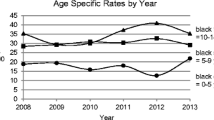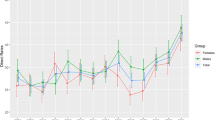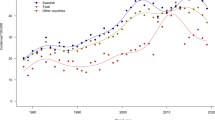Summary
During the period 1989–1994, 462 cases of insulin-dependent diabetes mellitus were registered among children from Northern Ireland aged under 15 years. The estimated completeness of the register was 98.8% (95% confidence interval (CI) 97.7%, 99.9%). A standardised rate of 19.6 (95% CI 17.8, 21.4) per 100 000 person years was obtained, placing Northern Ireland near the top of the range of published incidence in the United Kingdom, with a rate close to that reported for Scotland. In an analysis based on 217 postcode sectors, areas with a high population density and the most material deprivation were observed to have the lowest incidence rates. After inclusion of population density in a Poisson regression analysis, the component of deprivation which was found to be most significant was household crowding. Relative to children living in areas of low population density, there was a reduced risk for children in medium (relative incidence 0.85 (95% confidence limits CI 0.67,1.09)) and high (0.62 (95% CI 0.48,0.80)) population density areas. Similarly, relative to children living in areas with low levels of household crowding, there was a reduced risk for children in medium (relative incidence 0.73 (95% CI 0.58,0.93)) and high (0.67 (95%CI 0.53,0.83)) levels of household crowding. Tests for space-time clustering at diagnosis and at birth were negative. A possible explanation for the differences in incidence rate observed in this study is that exposure to infections very early in childhood is a protective factor. Later infections may act as either initiators or promoters of diabetes, but the absence of space-time clustering suggests that no single specific infectious agent is responsible.
Similar content being viewed by others
Abbreviations
- IDDM:
-
Insulin-dependent diabetes mellitus
- CI:
-
confidence interval
- SIR:
-
standardised incidence ratio
References
Hammon RF, Gay EC, Cruickshanks KJ et al. (1990) Colorado IDDM registry. Incidence and validation of IDDM in children aged 0–17 years. Diabetes Care 13: 499–506
Schoenle EJ, Semadeni S, Molinari L, Wiesendanger M, Bagot M (1994) Epidemiology of IDDM in Switzerland. Increasing incidence rate and rural-urban differences in Swiss men born 1948–72. Diabetes Care 17: 955–960
Crow YJ, Alberti KGMM, Parkin JM (1991) Insulin dependent diabetes in childhood and material deprivation in northern England, 1977–86. BMJ 303: 158–160
Patterson CC, Waugh NR (1992) Urban/rural and deprivational differences in incidence and clustering of childhood diabetes in Scotland. Int J Epidemiol 21: 108–117
Townsend P, Phillimore P, Beattie A (1988) Health and deprivation: inequality and the North. Croom Helm, London
Carstairs V, Morris R (1989) Deprivation and mortality: an alternative to social class? Comm Med 11: 210–219
Samuelsson U, Johansson C, Carstensen J, Ludvigsson J (1994) Space-time clustering in insulin-dependent diabetes mellitus (IDDM) in south-east Sweden. Int J Epidemiol 23: 138–142
Green A, Gale EAM, Patterson CC (1992) Incidence of childhood-onset insulin-dependent diabetes mellitus: the EURODIAB ACE study. Lancet 339: 905–909
Bishop YMM, Fienberg SE, Holland PW (1975) Estimating the size of a closed population. In: Discrete multivariate analysis: theory and practice. MIT Press, Cambridge, Massachusetts, pp 229–256
Roger JH (1977) A significance test for cyclic trends in incidence data. Biometrika 64: 152–155
Frome EL (1983) The analysis of rates using Poisson regression models. Biometrics 39: 665–674
Statistics and Epidemiology Research Corporation (1990) EGRET reference manual. Statistics and Epidemiology Research Corporation, Seattle
Mantel N (1967) The detection of disease clustering and a generalised regression approach. Cancer Res 27: 209–220
Office of Population Censuses and Surveys (1985) Central postcode directory user guide. 2nd edn. Her Majesty's Stationery Office, London
Lévy-Marchal C, Patterson C, Green A on behalf of the EURODIAB ACE Study Group (1995) Variation by age-group and seasonality at diagnosis of childhood IDDM in Europe. Diabetologia 38: 823–830
Bingley PJ, Gale EAM (1989) Incidence of insulin dependent diabetes in England: a study in the Oxford region, 1985–6. BMJ 298: 558–560
Staines A, Bodansky HJ, Lilley HEB, Stephenson C, McNally RJQ, Cartwright RA (1993) The epidemiology of diabetes mellitus in the United Kingdom: the Yorkshire Regional Childhood Diabetes Register. Diabetologia 36: 1282–1287
Waugh NR (1986) Insulin-dependent diabetes in a Scottish region: incidence and urban/rural differences. J Epidemiol Comm Hlth 40: 240–243
Patterson CC, Smith PG, Webb J, Heasman MA, Mann JI (1988) Geographical variation in the incidence of diabetes mellitus in Scottish children during the period 1977–1983. Diabet Med 5: 160–165
Bingley P, Gale EAM (1989) Rising incidence of IDDM in Europe. Diabetes Care 12: 289–295
Bloom A, Hayes TM, Gamble DR (1975) Register of newly diagnosed diabetic children. BMJ iii:580–583
Metcalfe MA, Baum JD (1991) Incidence of insulin dependent diabetes in children aged under 15 years in the British Isles during 1988. BMJ 302: 443–447
Barclay RPC, Craig JO, Galloway CAS, Richardson JE, Shepherd RC, Smail PJ (1988) The incidence of childhood diabetes in certain parts of Scotland. Scot Med J 33: 237–239
Siemiatycki J, Colle E, Campbell S, Dewar RAD, Belmonte MM (1989) Case-control study of IDDM. Diabetes Care 12: 209–216
Lawler-Heavner J, Cruickshanks KJ, Hamman RF, Gay EC, Klingensmith G, Chase HP (1991) Household density in early childhood and risk of insulin-dependent diabetes (IDDM). Diabetes 40[Suppl 1]:319A (Abstract)
Kolb H, Elliot RB (1994) Increasing incidence of IDDM a consequence of improved hygiene? Diabetologia 37: 731 (Letter)
Patterson CC, Carson DJ, Hadden DR, Waugh NR, Cole SK (1994) A case-control investigation of perinatal risk factors for childhood IDDM in Northern Ireland and Scotland. Diabetes Care 17:376–381
Dahlquist G, KÄllen B (1992) Maternal-child blood-group incompatibility and other perinatal events increase the risk for early-onset type 1 (insulin-dependent) diabetes mellitus. Diabetologia 35: 671–675
Leiter EH, Serreze DV, Prochazka M (1990) The genetics and epidemiology of diabetes in NOD mice. Immunology Today 11: 147–149
Blom L, Nyström L, Dahlquist G (1991) The Swedish childhood diabetes study. Vaccinations and infections as risk determinants for diabetes in childhood. Diabetologia 34: 176–181
Verge CF, Howard NJ, Irwig L, Simpson JD, Mackerras D, Silink M (1994) Environmental factors in childhood IDDM. A population-based, case-control study. Diabetes Care 17: 1381–1389
Glatthaar C, Whittall DE, Welborn TA et al.(1988) Diabetes in Western Australian children: descriptive epidemiology. Med J Aust 148: 117–123
Siemiatycki J, Colle E, Aubert D, Campbell S, Belmonte MM (1986) The distribution of type I (insulin-dependent) diabetes mellitus by age, sex, secular trend, seasonality, time clusters and space-time clusters: evidence from Montreal 1971–1983. Am J Epidemiol 124: 545–560
Dahlquist G (1993) Etiological aspects of insulin-dependent diabetes mellitus: an epidemiological perspective. Autoimmunity 15: 61–65
Author information
Authors and Affiliations
Consortia
Rights and permissions
About this article
Cite this article
Patterson, C.C., Carson, D.J., Hadden, D.R. et al. Epidemiology of childhood IDDM in Northern Ireland 1989–1994: Low incidence in areas with highest population density and most household crowding. Diabetologia 39, 1063–1069 (1996). https://doi.org/10.1007/BF00400655
Received:
Revised:
Issue Date:
DOI: https://doi.org/10.1007/BF00400655




